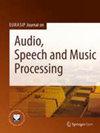An acoustic echo canceller optimized for hands-free speech telecommunication in large vehicle cabins
IF 1.9
3区 计算机科学
引用次数: 0
Abstract
Abstract Acoustic echo cancelation (AEC) is a system identification problem that has been addressed by various techniques and most commonly by normalized least mean square (NLMS) adaptive algorithms. However, performing a successful AEC in large commercial vehicles has proved complicated due to the size and challenging variations in the acoustic characteristics of their cabins. Here, we present a wideband fully linear time domain NLMS algorithm for AEC that is enhanced by a statistical double-talk detector (DTD) and a voice activity detector (VAD). The proposed solution was tested in four main Volvo truck models, with various cabin geometries, using standard Swedish hearing-in-noise (HINT) sentences in the presence and absence of engine noise. The results show that the proposed solution achieves a high echo return loss enhancement (ERLE) of at least 25 dB with a fast convergence time, fulfilling ITU G.168 requirements. The presented solution was particularly developed to provide a practical compromise between accuracy and computational cost to allow its real-time implementation on commercial digital signal processors (DSPs). A real-time implementation of the solution was coded in C on an ARM Cortex M-7 DSP. The algorithmic latency was measured at less than 26 ms for processing each 50-ms buffer indicating the computational feasibility of the proposed solution for real-time implementation on common DSPs and embedded systems with limited computational and memory resources. MATLAB source codes and related audio files are made available online for reference and further development.一种针对大型汽车舱内免提语音通信优化的回声消除器
声学回波消除(AEC)是一个系统识别问题,已经被各种技术解决,最常用的是归一化最小均方(NLMS)自适应算法。然而,由于大型商用车的尺寸和客舱声学特性的变化,在大型商用车上成功实施AEC已经被证明是复杂的。在这里,我们提出了一种用于AEC的宽带全线性时域NLMS算法,该算法通过统计双话检测器(DTD)和语音活动检测器(VAD)进行了增强。提出的解决方案在四种主要的沃尔沃卡车车型上进行了测试,这些车型具有不同的客舱几何形状,在存在和不存在发动机噪音的情况下,使用标准的瑞典噪音听力(HINT)语句。结果表明,该方案实现了至少25 dB的高回波回波损耗增强(ERLE),且收敛时间快,满足ITU G.168要求。提出的解决方案是为了在精度和计算成本之间提供一个实际的折衷,以允许其在商业数字信号处理器(dsp)上实时实现。在ARM Cortex M-7 DSP上用C语言编写了该方案的实时实现。算法延迟在处理每个50 ms缓冲区时小于26 ms,这表明所提出的解决方案在计算和内存资源有限的通用dsp和嵌入式系统上实时实现的计算可行性。MATLAB源代码和相关音频文件已在网上提供,供参考和进一步开发。
本文章由计算机程序翻译,如有差异,请以英文原文为准。
求助全文
约1分钟内获得全文
求助全文
来源期刊

Journal on Audio Speech and Music Processing
Engineering-Electrical and Electronic Engineering
CiteScore
4.10
自引率
4.20%
发文量
28
期刊介绍:
The aim of “EURASIP Journal on Audio, Speech, and Music Processing” is to bring together researchers, scientists and engineers working on the theory and applications of the processing of various audio signals, with a specific focus on speech and music. EURASIP Journal on Audio, Speech, and Music Processing will be an interdisciplinary journal for the dissemination of all basic and applied aspects of speech communication and audio processes.
 求助内容:
求助内容: 应助结果提醒方式:
应助结果提醒方式:


